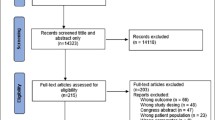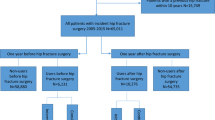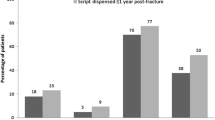Abstract
Summary
Hip fracture is associated with recurrent fractures and increased mortality. The results of our retrospective cohort study support the use of antiresorptive agents to prevent recurrent hip fractures in this population.
Introduction
Hip fracture, the most serious consequence of osteoporosis, is associated with recurrent fractures and increased mortality. Antiresorptive therapy has proven efficacy in the prevention of fractures after vertebral fractures. It is unknown if it can prevent recurrent fractures after a hip fracture.
Methods
We designed a population based, retrospective cohort study, using administrative databases and identified patients hospitalized for a hip fracture between 1996 and 2002. The exposure was defined as being dispensed a prescription for an antiresorptive agent at any time following discharge. Multivariate Cox regression models were used to estimate the hazard ratio of recurrent hip fracture. Subgroup and propensity score analyses were performed.
Results
A total of 20,644 patients were identified; 6,779 filled a prescription for antiresorptive agents. There were 992 recurrent hip fractures. Patients exposed to antiresorptives had a 26% reduction in the rate of recurrent fractures (adjusted hazard ratio 0.74; 95% CI, 0.64–0.86) compared to patients who were not. All subgroups experienced a reduction in recurrent fracture, except the very elderly. Propensity score analyses were consistent with the main analysis.
Conclusions
Antiresorptive therapy reduces the risk of recurrent hip fractures in elderly patients. These results provide evidence that this therapy should be considered for secondary prevention of hip fractures.



Similar content being viewed by others
References
(2001) Osteoporosis prevention, diagnosis, and therapy. JAMA 285(6):785–795
U.S Department of health and human services. Bone health and osteoporosis: A report of the Surgeon General. Rockville, MD: U.S. Department of Health and Human services, Offices of the Surgeon General, 2004. 2006. Ref Type: Generic
Sambrook P, Cooper C (2006) Osteoporosis. Lancet 367(9527):2010–2018
Cummings SR, Melton LJ (2002) Epidemiology and outcomes of osteoporotic fractures. Lancet 359(9319):1761–1767
Giversen IM (2007) Time trends of mortality after first hip fractures. Osteoporos Int 18(6):721–732
Colon-Emeric CS, Caminis J, Suh TT, Pieper CF, Janning C, Magaziner J et al (2004) The HORIZON Recurrent Fracture Trial: design of a clinical trial in the prevention of subsequent fractures after low trauma hip fracture repair. Curr Med Res Opin 20(6):903–910
Center JR, Nguyen TV, Schneider D, Sambrook PN, Eisman JA (1999) Mortality after all major types of osteoporotic fracture in men and women: an observational study. Lancet 353(9156):878–882
Bischoff-Ferrari HA, Dawson-Hughes B, Willett WC, Staehelin HB, Bazemore MG, Zee RY et al (2004) Effect of Vitamin D on falls: a meta-analysis. JAMA 291(16):1999–2006
Bischoff-Ferrari HA, Willett WC, Wong JB, Giovannucci E, Dietrich T, Dawson-Hughes B (2005) Fracture prevention with vitamin D supplementation: a meta-analysis of randomized controlled trials. JAMA 293(18):2257–2264
Cranney A, Guyatt G, Griffith L, Wells G, Tugwell P, Rosen C (2002) Meta-analyses of therapies for postmenopausal osteoporosis. IX: Summary of meta-analyses of therapies for postmenopausal osteoporosis. Endocr Rev 23(4):570–578
Rossouw JE, Anderson GL, Prentice RL, LaCroix AZ, Kooperberg C, Stefanick ML et al (2002) Risks and benefits of estrogen plus progestin in healthy postmenopausal women: principal results From the Women’s Health Initiative randomized controlled trial. JAMA 288(3):321–333
Nguyen ND, Eisman JA, Nguyen TV (2006) Anti-hip fracture efficacy of biophosphonates: a Bayesian analysis of clinical trials. J Bone Miner Res 21(2):340–349
Sawka AM, Papaioannou A, Adachi JD, Gafni A, Hanley DA, Thabane L (2005) Does alendronate reduce the risk of fracture in men? A meta-analysis incorporating prior knowledge of anti-fracture efficacy in women. BMC Musculoskelet Disord 6:39
Ringe JD, Faber H, Farahmand P, Dorst A (2006) Efficacy of risedronate in men with primary and secondary osteoporosis: results of a 1-year study. Rheumatol Int 26(5):427–431
Watts NB, Worley K, Solis A, Doyle J, Sheer R (2004) Comparison of risedronate to alendronate and calcitonin for early reduction of nonvertebral fracture risk: results from a managed care administrative claims database. J Manag Care Pharm 10(2):142–151
Siris ES, Harris ST, Rosen CJ, Barr CE, Arvesen JN, Abbott TA et al (2006) Adherence to bisphosphonate therapy and fracture rates in osteoporotic women: relationship to vertebral and nonvertebral fractures from 2 US claims databases. Mayo Clin Proc 81(8):1013–1022
Kanis JA, Borgstrom F, De Laet C, Johansson H, Johnell O, Jonsson B et al (2005) Assessment of fracture risk. Osteoporos Int 16(6):581–589
Compston J (2005) Guidelines for the management of osteoporosis: the present and the future. Osteoporos Int 16(10):1173–1176
Pilote L, Lavoie F, Ho V, Eisenberg MJ (2000) Changes in the treatment and outcomes of acute myocardial infarction in Quebec, 1988–1995. CMAJ 163(1):31–36
Levy AR, Tamblyn RM, Fitchett D, McLeod PJ, Hanley JA (1999) Coding accuracy of hospital discharge data for elderly survivors of myocardial infarction. Can J Cardiol 15(11):1277–1282
Tamblyn R, Lavoie G, Petrella L, Monette J (1995) The use of prescription claims databases in pharmacoepidemiological research: the accuracy and comprehensiveness of the prescription claims database in Quebec. J Clin Epidemiol 48(8):999–1009
Zhou Z, Rahme E, Abrahamowicz M, Pilote L (2005) Survival bias associated with time-to-treatment initiation in drug effectiveness evaluation: a comparison of methods. Am J Epidemiol 162(10):1016–1023
Cummings SR, Nevitt MC, Browner WS, Stone K, Fox KM, Ensrud KE et al (1995) Risk factors for hip fracture in white women. Study of Osteoporotic Fractures Research Group. N Engl J Med 332(12):767–773
Colon-Emeric CS, Pieper CF, Artz MB (2002) Can historical and functional risk factors be used to predict fractures in community-dwelling older adults? development and validation of a clinical tool. Osteoporos Int 13(12):955–961
Brown JP, Josse RG (2002) 2002 clinical practice guidelines for the diagnosis and management of osteoporosis in Canada. CMAJ 167(10 Suppl):S1–34
Nguyen ND, Pongchaiyakul C, Center JR, Eisman JA, Nguyen TV (2005) Identification of high-risk individuals for hip fracture: a 14-year prospective study. J Bone Miner Res 20(11):1921–1928
Becker C, Crow S, Toman J, Lipton C, McMahon D, Macaulay W et al (2006) Characteristics of elderly patients admitted to an urban tertiary care hospital with osteoporotic fractures: correlations with risk factors, fracture type, gender and ethnicity. Osteoporosis International 1–7
Taylor BC, Schreiner PJ, Stone KL, Fink HA, Cummings SR, Nevitt MC et al (2004) Long-term prediction of incident hip fracture risk in elderly white women: study of osteoporotic fractures. J Am Geriatr Soc 52(9):1479–1486
Romano PS, Roos LL, Jollis JG (1993) Adapting a clinical comorbidity index for use with ICD-9-CM administrative data: differing perspectives. J Clin Epidemiol 46(10):1075–1079
Boonen S, McClung MR, Eastell R, El Hajj FG, Barton IP, Delmas P (2004) Safety and efficacy of risedronate in reducing fracture risk in osteoporotic women aged 80 and older: implications for the use of antiresorptive agents in the old and oldest old. J Am Geriatr Soc 52(11):1832–1839
Sikka R, Xia F, Aubert RE (2005) Estimating medication persistency using administrative claims data. Am J Manag Care 11(7):449–457
Shah BR, Laupacis A, Hux JE, Austin PC (2005) Propensity score methods gave similar results to traditional regression modeling in observational studies: a systematic review. J Clin Epidemiol 58(6):550–559
D’Agostino RB Jr, D’Agostino RB Sr (2007) Estimating treatment effects using observational data. JAMA 297(3):314–316
Moniz C, Dew T, Dixon T (2005) Prevalence of vitamin D inadequacy in osteoporotic hip fracture patients in London. Curr Med Res Opin 21(12):1891–1894
Holick MF (2006) High prevalence of vitamin D inadequacy and implications for health. Mayo Clin Proc 81(3):353–373
Heckman GA, Papaioannou A, Sebaldt RJ, Ioannidis G, Petrie A, Goldsmith C et al (2002) Effect of vitamin D on bone mineral density of elderly patients with osteoporosis responding poorly to bisphosphonates. BMC Musculoskelet Disord 3:6
Davison KS, Siminoski K, Adachi JD, Hanley DA, Goltzman D, Hodsman AB et al (2006) The effects of antifracture therapies on the components of bone strength: assessment of fracture risk today and in the future. Semin Arthritis Rheum 36(1):10–21
Wallace DJ (2005) Rapid prevention of vertebral fractures associated with osteoporosis. Orthopedics 28(3):291–298
Nymark T, Lauritsen JM, Ovesen O, Rock ND, Jeune B (2006) Short time-frame from first to second hip fracture in the Funen County Hip Fracture Study. Osteoporos Int 17(9):1353–1357
Gold DT (2006) Medication adherence: a challenge for patients with postmenopausal osteoporosis and other chronic illnesses. J Manag Care Pharm 12(6 Suppl A):20–25
Siris ES (2006) Patients with hip fracture: what can be improved? Bone 38(2 Suppl 2):8–12
Marshall D, Johnell O, Wedel H (1996) Meta-analysis of how well measures of bone mineral density predict occurrence of osteoporotic fractures. BMJ 312(7041):1254–1259
Tinetti ME, Doucette J, Claus E, Marottoli R (1995) Risk factors for serious injury during falls by older persons in the community. J Am Geriatr Soc 43(11):1214–1221
Zhou Z, Rahme E, Abrahamowicz M, Tu JV, Eisenberg MJ, Humphries K et al (2005) Effectiveness of statins for secondary prevention in elderly patients after acute myocardial infarction: an evaluation of class effect. CMAJ 172(9):1187–1194
Duque G, Mallet L, Roberts A, Gingrass S, Kremer R, Sainte-Marie LG et al (2007) To treat or not to treat, that is the question: proceedings of the Quebec symposium for the treatment of osteoporosis in long-term care institutions, Saint-Hyacinthe, Quebec, November 5, 2004. J Am Med Dir Assoc 8(3 Suppl 2):e67–e73
Ytterstad B (1999) The Harstad injury prevention study: the characteristics and distribution of fractures amongst elders-an eight year study. Int J Circumpolar Health 58(2):84–95
Province MA, Hadley EC, Hornbrook MC, Lipsitz LA, Miller JP, Mulrow CD et al (1995) The effects of exercise on falls in elderly patients. A preplanned meta-analysis of the FICSIT Trials. Frailty and Injuries: Cooperative Studies of Intervention Techniques. JAMA 273(17):1341–1347
Acknowledgements
This study was funded in part by grant #ATF 6669 from the Canadian Institutes of Health Research. Dr. Morin is a scholar of the CIHR Skeletal Health Training Program. The funding agency had no role in the design of the study, in the collection, analysis and interpretation of the data, in the writing of the manuscript and in the decision to submit the paper for publication.
Conflict of interest statement
Dr. Morin has received honoraria (consultant and speaker fees) from the Alliance for Better Bone Health, Merck and Eli Lilly. Dr. Rahme has received grants and consultant fees from Merck, Pfizer and Boehringer Ingelheim. All other authors have no conflict of interest.
Authors contributions:
-
Drs Morin and Pilote were responsible for the conception of the study.
-
Dr. Pilote was responsible for acquisition of the data.
-
Drs. Morin and Behlouli were responsible for the data programming.
-
Drs. Morin, Pilote, Rahme, Behlouli and Goltzman were responsible for the design of the study, data analysis and interpretation.
-
Dr. Morin was responsible for writing the manuscript.
-
All authors were responsible for revising the manuscript critically for important intellectual content.
-
All authors have seen and approved the final version of the manuscript.
Author information
Authors and Affiliations
Corresponding author
Additional information
Dr. Morin is a Canadian Institutes of Health Research Bone Scholar, Dr. Pilote is funded by the Canadian Institutes of Health Research. Dr. Pilote is a William Dawson Professor of Medicine at McGill University. This study was supported in part by a grant from the Canadian Institutes of Health Research (#ATF-66669).
Rights and permissions
About this article
Cite this article
Morin, S., Rahme, E., Behlouli, H. et al. Effectiveness of antiresorptive agents in the prevention of recurrent hip fractures. Osteoporos Int 18, 1625–1632 (2007). https://doi.org/10.1007/s00198-007-0421-1
Received:
Accepted:
Published:
Issue Date:
DOI: https://doi.org/10.1007/s00198-007-0421-1




